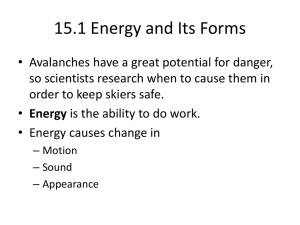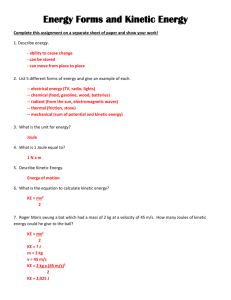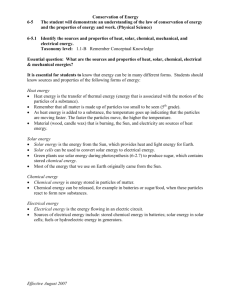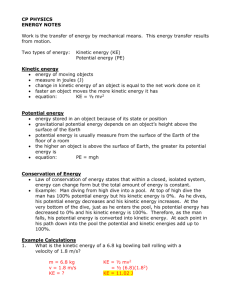Work, Energy and Power
advertisement
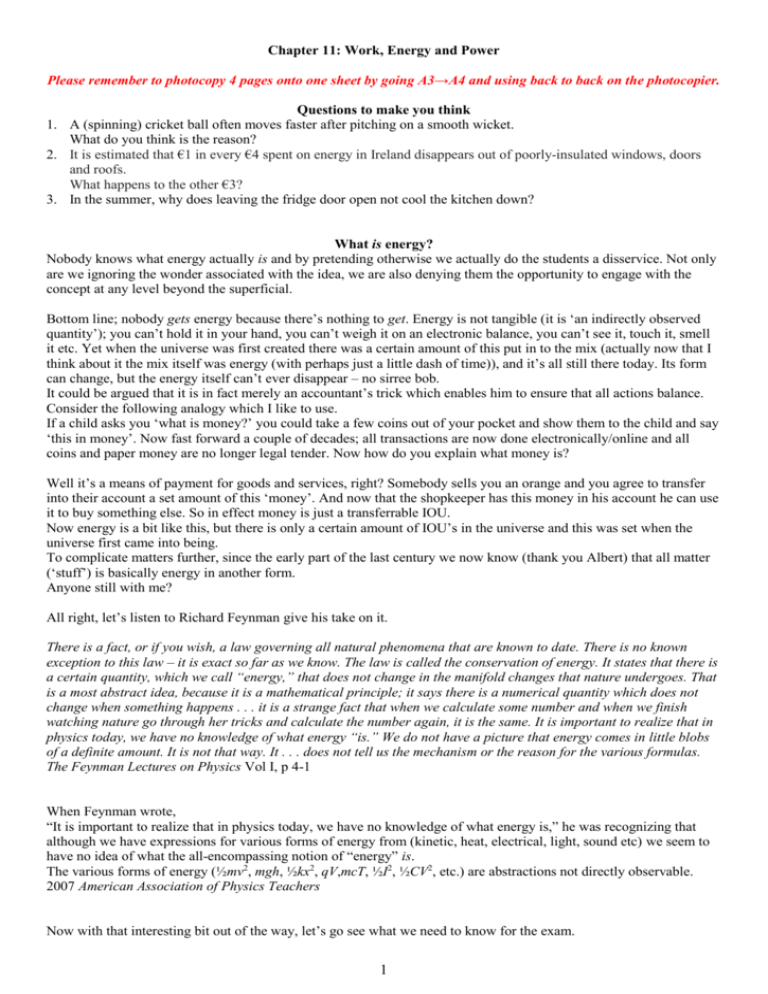
Chapter 11: Work, Energy and Power Please remember to photocopy 4 pages onto one sheet by going A3→A4 and using back to back on the photocopier. Questions to make you think 1. A (spinning) cricket ball often moves faster after pitching on a smooth wicket. What do you think is the reason? 2. It is estimated that €1 in every €4 spent on energy in Ireland disappears out of poorly-insulated windows, doors and roofs. What happens to the other €3? 3. In the summer, why does leaving the fridge door open not cool the kitchen down? What is energy? Nobody knows what energy actually is and by pretending otherwise we actually do the students a disservice. Not only are we ignoring the wonder associated with the idea, we are also denying them the opportunity to engage with the concept at any level beyond the superficial. Bottom line; nobody gets energy because there’s nothing to get. Energy is not tangible (it is ‘an indirectly observed quantity’); you can’t hold it in your hand, you can’t weigh it on an electronic balance, you can’t see it, touch it, smell it etc. Yet when the universe was first created there was a certain amount of this put in to the mix (actually now that I think about it the mix itself was energy (with perhaps just a little dash of time)), and it’s all still there today. Its form can change, but the energy itself can’t ever disappear – no sirree bob. It could be argued that it is in fact merely an accountant’s trick which enables him to ensure that all actions balance. Consider the following analogy which I like to use. If a child asks you ‘what is money?’ you could take a few coins out of your pocket and show them to the child and say ‘this in money’. Now fast forward a couple of decades; all transactions are now done electronically/online and all coins and paper money are no longer legal tender. Now how do you explain what money is? Well it’s a means of payment for goods and services, right? Somebody sells you an orange and you agree to transfer into their account a set amount of this ‘money’. And now that the shopkeeper has this money in his account he can use it to buy something else. So in effect money is just a transferrable IOU. Now energy is a bit like this, but there is only a certain amount of IOU’s in the universe and this was set when the universe first came into being. To complicate matters further, since the early part of the last century we now know (thank you Albert) that all matter (‘stuff’) is basically energy in another form. Anyone still with me? All right, let’s listen to Richard Feynman give his take on it. There is a fact, or if you wish, a law governing all natural phenomena that are known to date. There is no known exception to this law – it is exact so far as we know. The law is called the conservation of energy. It states that there is a certain quantity, which we call “energy,” that does not change in the manifold changes that nature undergoes. That is a most abstract idea, because it is a mathematical principle; it says there is a numerical quantity which does not change when something happens . . . it is a strange fact that when we calculate some number and when we finish watching nature go through her tricks and calculate the number again, it is the same. It is important to realize that in physics today, we have no knowledge of what energy “is.” We do not have a picture that energy comes in little blobs of a definite amount. It is not that way. It . . . does not tell us the mechanism or the reason for the various formulas. The Feynman Lectures on Physics Vol I, p 4-1 When Feynman wrote, “It is important to realize that in physics today, we have no knowledge of what energy is,” he was recognizing that although we have expressions for various forms of energy from (kinetic, heat, electrical, light, sound etc) we seem to have no idea of what the all-encompassing notion of “energy” is. The various forms of energy (½mv2, mgh, ½kx2, qV,mcT, ½I2, ½CV2, etc.) are abstractions not directly observable. 2007 American Association of Physics Teachers Now with that interesting bit out of the way, let’s go see what we need to know for the exam. 1 2 Student notes Work is defined as the product of force and displacement. Work = Force × displacement* The unit of work is the Joule (J). W=F×s Energy is the ability to do work. The amount of energy something has is also the amount of work it can do. Because work is a form of energy it follows that the unit of energy is also the Joule. Work-Energy Principle The change in the energy of an object is equal to the work done on the object Different Forms of Energy Kinetic Energy is energy an object has due to its motion. Formula for Kinetic Energy: EK = ½ mv2 * Potential Energy is the energy an object has due to its position in a force field. The formula for Potential Energy: EP = mgh Any time work is done energy is transferred* The Principle of Conservation of Energy* states that energy cannot be created or destroyed but can only be converted from one form to another. Loss in Potential Energy = Gain in Kinetic Energy for a freely falling object* The Solar Constant is the average amount of the Sun’s energy falling normally on one metre squared of the Earth’s atmosphere per second. Collisions: Kinetic Energy and Momentum When two objects collide, momentum is conserved provided no external forces act on the system. Kinetic energy however is not conserved. This is because some of the kinetic energy gets converted to sound and heat energy. This is a common exam question. 3 Power Power is the rate at which work is done. Or Power is the rate at which energy is converted from one form to another. The unit of power is the Watt (W). 𝐏𝐨𝐰𝐞𝐫 = 𝐖𝐨𝐫𝐤_𝐃𝐨𝐧𝐞 𝐓𝐢𝐦𝐞_𝐓𝐚𝐤𝐞𝐧 To Estimate the Power developed by a person running up a flight of stairs 1. Calculate the work done in going up the stairs. This will be the same as your potential energy at the top (mgh), where m is your mass (you will need a bathroom scales). 2. Time how long it takes to run up a flight of stairs. 3. Divide the work by the time taken. How does your power (kept up for a few seconds) compare with that of a horse over a working day (550 W)? Did you know that the average brain uses 12 Watts of power (less than a laptop)? For some of you this may be a bit optimistic. Percentage Efficiency No machine is 100% efficient – some energy is always ‘lost’ in the process. This is why we can never have a ‘Perpetual Motion’ machine. Formula to calculate how efficient a machine is: 𝑷𝒆𝒓𝒄𝒆𝒏𝒕𝒂𝒈𝒆 𝑬𝒇𝒇𝒊𝒄𝒊𝒆𝒏𝒄𝒚 = 𝑷𝒐𝒘𝒆𝒓 𝑶𝒖𝒕 𝟏𝟎𝟎 × 𝑷𝒐𝒘𝒆𝒓 𝑰𝒏 𝟏 Questions to make you think 1. Why is a microwave oven much more efficient at cooking than using a regular oven or gas cooker? The Solar Constant The solar constant represents the average amount of energy falling normally on each square metre of the earth’s atmosphere in one second. Its value is approximately 1.35 kW m-2 but this can change from one place to another. Can you think why? 4 Leaving Cert Physics Syllabus Content Depth of Treatment Activities STS 1. Work Definition and unit. Simple experiments. Appropriate calculations involving force and displacement in the same direction only. Lifts, escalators. 2. Energy Energy as the ability to do work. Different forms of energy. Ep = mgh Ek = ½ mv2 Conversions of one form of energy to another. Principle of conservation of energy. Demonstration of different energy conversions. Appropriate calculations. Sources of energy: renewable and nonrenewable. Efficient use of energy in the home. Solar constant (also called solar irradiance). 3. Power Power as the rate of doing work or Rate of energy conversion. Unit Estimation of average power developed by Person running upstairs Person repeatedly lifting weights etc. Appropriate calculations Percentage Efficiency = Power Out 100 × Power In 1 5 . Power of devices, e.g. light bulbs, motors, etc. Extra Credit *Work = Force × Displacement The Force and Displacement must be in the same direction; if they are not they you have calculate and use the component of the force which is in the same direction as the displacement. * E = ½ mv2 This means that the Energy a car has (and therefore its driver) is proportional to the square of the velocity. If your speed increases by a factor of two (say from 20 mph to 40 mph), the energy increases by a factor of four. If your speed increases by a factor of three (say from 20 mph to 60 mph), the energy increases by a factor of nine! *Anytime work is done energy is transferred This is a very important concept but is often overlooked by students. We will come across it again when dealing with an electron getting accelerated between two points. By which time you will all have forgotten about this. When a body does work it loses energy. For example if you carry a block upstairs, you do work and the chemical energy in your muscles decreases. If work is done on an object it gains energy. The block gains energy as it moves up. *The Principle of Conservation of Energy This means that all the energy all around us could only have come from the Big Bang 15 billion years ago – imagine that! Every sound you hear, every movement you make, all that energy originally came from something the size of a pinhead. Personally I think that’s mind-blowing. If you don’t then maybe it’s not too late to give up Physics and switch to Accounting. Now while this energy can’t disappear (you can’t actually waste energy), it can only change form. This is what an Energy Conversion is. Energy conversions are going on all around us all the time. The problem with these energy conversions is that either they are taking a less useful form (lightbulb giving out heat) or the useful energy going out is less than the energy taken in (power stations). The technical term is that the energy is ‘less ordered’, or ‘more chaotic’. *Loss in Potential Energy = Gain in Kinetic Energy for a freely falling object This means that the total energy of the object is the same at any point in its trajectory (‘freely falling’ means no external forces). Note that when an object is thrown up the opposite holds, i.e. gain in potential energy = loss in kinetic energy. You could check this for yourself by looking at a mass of say 10 kg, thrown up with an initial velocity of 100 m/s. Find how far up it goes (how? – hint; use equations of motion), and then find its potential and kinetic energies at the bottom, half way up and at the top. In each case they will have the same total (potential + kinetic) at each point. A couple of very important problems are shown on page 129; Problems 10, 11 and 12. Newton’s Cradle When two balls go in, two go out at (almost) the same speed: Momentum is conserved, although Kinetic Energy is not. So why, if two go in, can't one go out at twice the velocity? Turns out momentum would be conserved, but Kinetic Energy wouldn't. Try working it out by letting the mass of each sphere be m, and the initial velocity be v. Demonstrating Energy Wave a magnet in and out of a coil of wire. Connect the coil to an l.e.d. or to a galvanometer. Note that current is produced by relative motion between the two. This in fact is where almost all our electricity comes from. All the various generating stations do is come up with different ways of heating water to produce steam to move a magnet in and out of a coil of wire. Some generating stations e.g. windmills, can get the magnet to move directly without needing to heat anything. Wave a bar magnet around a magnetic compass and talk about the moving flux causing the needle to move. "You are producing radio waves". If you have a hand cranked dynamo it gets harder to turn as more light bulbs are powered by it - you have to supply the extra energy somehow! 6 Exam Questions Work 1. [2007 OL] Define work and give the unit of measurement. 2. [2006 OL] A person pushed a car a distance of 15 m with a force of 500 N. Calculate the work done by the person. 3. [2002 OL] The force T exerted by the engine in an aircraft is 20 000 N. Calculate the work done by the engines while the aircraft travels a distance of 500 km. Energy 4. [2005 OL] Define energy. 5. [2009 OL] Which of the following is the unit of energy; kilogram, watt, joule, ampere? 6. [2008][2005] State the principle of conservation of energy. 7. [2010 OL] Define kinetic energy 8. [2005 OL] Name one method of producing electricity. 9. [2005 OL] What type of energy is associated with wind, waves and moving water? 10. [2007 OL] Which of the following is not a renewable source of energy: wind, nuclear, solar, hydroelectric? 11. [2005 OL] Give one disadvantage of non-renewable energy sources. 12. [2005 OL] How does the sun produce heat and light? 13. [2003 OL] State one energy conversion that takes place in an electrical generator. 14. [2005 OL] What energy conversion takes place when a fuel is burnt? 15. [2004 OL] What energy conversion takes place in a solar panel? 16. [2008] Why is a fluorescent tube an efficient source of light? 17. [2007] Why is a filament light bulb not an efficient source of light? 18. [2007 OL] What is the difference between potential energy and kinetic energy? 19. [2005 OL] Give one factor on which the potential energy of a body depends. 7 Energy: Maths questions 20. [2004 OL] A student holds a metal ball 2 m above the ground. The mass of the ball is 5 kg. Calculate the potential energy of the ball. 21. [2002 OL] A car of mass 800 kg is travelling at 10 m s-1. What is its kinetic energy? 22. [2009 OL] A train of mass 30000 kg can reached a top speed of 50 m s−1. As the train approached the next station the driver applied the brakes uniformly to bring the train to a stop. (i) Calculate the kinetic energy lost by the train in stopping. (ii) What happened to the kinetic energy lost by the train? 23. [2010 OL] (i) An ice skater of mass 50 kg was moving with a speed of 6 m s−1 then she collides with another skater of mass 70 kg who was standing still. The two skaters then moved off together at a speed of 2.5 m s−1. Calculate the kinetic energy of each skater before the collision. (ii) Calculate the kinetic energy of the pair of skaters after the collision. (iii)Comment on the total kinetic energy values before and after the collision. 24. [2008] In a pole-vaulting competition an athlete, whose centre of gravity is 1.1 m above the ground, sprints from rest and reaches a maximum velocity of 9.2 ms–1. What is the maximum height above the ground that the athlete can raise his centre of gravity? 25. [2004] A pendulum bob was raised to a height of 20 cm and allowed to swing so that it collided with a block at rest on a bench, as shown. Calculate the velocity of the bob just before the collision. Hint To find the velocity of the object at the bottom we note that potential energy at the top equals kinetic energy at the bottom, i.e. mgh = ½ mv2, but we could also have used equations of motion, i.e. v2 = u2 +2as, and that too would have given us the velocity. Therefore the velocity a pendulum has at the bottom of a swing is the same as that which it would have if it were falling straight down (freefall)! 26. [2005] A basketball of mass 600 g which was resting on a hoop falls to the ground 3.05 m below. (i) What is the maximum kinetic energy of the ball as it falls? (ii) On bouncing from the ground the ball loses 6 joules of energy. What happens to the energy lost by the ball? (iii) Calculate the height of the first bounce of the ball. 8 Power 27. [2002][2006][2007 OL] Define power. 28. [2005 OL][2007 OL] What is the unit of power? 29. [2008] A toaster has a power rating of 1050 W when it is connected to the mains supply. Calculate the heat generated by the toaster in 2 minutes if it has an efficiency of 96%. 30. [2002 OL] A kettle uses 532 950 J to boil water. If it takes 4 minutes calculate the power of the kettle. 31. [2006 OL] During a ten-hour period the energy gained by the bricks in a storage heater is 34.2 MJ. Calculate the power of the heating coil. 32. [2007 OL] An empty lift has a weight of 7200 N and is powered by an electric motor. The lift takes a person up 25 m in 40 seconds. The person weighs 800 N. (i) Calculate the total weight raised by the lift’s motor. (ii) Calculate the work done by the lift’s motor. (iii) Calculate the power output of the motor. (iv) Calculate the energy gained by the person in taking the lift. (v) If instead the person climbed the stairs to the same height in 2 minutes, calculate the power generated by the person in climbing the stairs. (vi) Give two disadvantages of using a lift. 33. [2003] A person in a wheelchair is moving up a ramp. The force required to keep the wheelchair moving at a constant speed up the ramp is 156.3 N. The ramp is 5 m long. Calculate the power exerted by the person in the wheelchair if it takes her 10 s to travel up the ramp. The Solar Constant 34. [2006] The average value for the solar constant in Ireland is 1.2 × 102 W m–2. What is the average energy falling normally on an area of 5 m2 of ground in Ireland in 1 minute? 35. [2002] The solar constant is 1.35 kW m-2. What is the average amount of energy falling normally on each square metre of the earth’s atmosphere in one year? (one year = 3.16 × 10 7s) 36. [2009] What is the max energy that can fall on an area of 8 m2 in one hour if the solar constant is 1350 W m–2? 37. [2014] The U-value of the material in a double-glazed window in a house is 2.8 W m–2 K–1. The window has an area of 3.0 m2. How much energy is lost through the window in one hour if the temperature inside the house is 20 °C and the outside temperature is 11 °C? 38. [2007] A large number of solar cells are joined together in series and cover an area of 20 m2. The efficiency of the solar cells is 20%. If the solar constant is 1400 W m–2, what is the maximum power generated by the solar cells? 39. [2007] Nuclear power generates three hundred gigawatts of energy worldwide. How much energy is generated worldwide every minute by nuclear power today? 9 40. (a) (b) (c) (d) (e) (f) (g) (h) [2008 OL] State two uses of energy in the home. Give two ways to reduce energy needs in the home. List the main sources of renewable energy. What are the main parts of a solar heating system? Why does a solar panel need to face south? What is the function of the backup heater? Why are parts of the solar panel painted black? What is the name given to the tendency of water to circulate as it is heated? 10 Exam Solutions Work 1. Work is the product of force by displacement (distance). Unit: joule 2. Work = Force × distance = 500 × 15 = 7,500 J. 3. Work = Force × displacement 20000 × 500 000 = 1 × 1010 (J) Energy 4. Energy is defined as the ability to do work. 5. The joule 6. The Principle of Conservation of Energy states that energy cannot be created or destroyed but can only be converted from one form to another. 7. Kinetic energy is energy an object has due to its motion. 8. Solar, wind, wave, tidal, biomass, coal, oil, gas, hydroelectricity, geothermal, nuclear, uranium, turf. 9. Renewable energy. 10. Nuclear 11. They will run out. 12. Through nuclear reactions. 13. Kinetic to electric. 14. Chemical to heat. 15. Light to electricity, light to heat. 16. Most of the (electrical) energy is converted to light (energy) 17. Almost all of the energy is given off as heat. 18. Potential energy is energy a body has due to its position; kinetic energy is energy a body has due to its motion. 19. Mass, height, acceleration due to gravity (g). Energy: Maths questions 20. Ep = mgh = 5 × 9.8 × 2 = 98 J. 21. Ek = ½mv2 E = ½ 800 × 102 E = 40,000 J 22. (i) Ek = ½mv2 Ek = ½ (30000)(50)2 = 37500000 J = 37.5 MJ (ii) It was converted to other forms of energy such as heat, sound and light (from sparks). 23. (i) Ek = ½mv2 Ek = ½ 50 × 62 = 900 J Ek = ½ 70 × 0 = 0 J (ii) Ek = ½ 120 × (2.5)2 = 375 (J) (iii)Kinetic energy not conserved in collision because some of the energy was given off as heat and sound. 24. K.E. = P.E. ½ mv2 = mgh h = v2/2g = (9.2)2/2(9.8) = 4.32 Max height above the ground = 4.32 + 1.1 = 5.42 m. 25. Loss in P.E = gain in K.E mgh = ½ mv2 v2 = 2gh = 2(9.8)(0.2) v = 1.98 m s-1 26. (i) KE = PE (at height of 3.05 m) ½mv2 = mgh mgh = (0.6)(9.8)(3.05) = 17.9 J Ek = 17.9 J (ii) It changes into sound and heat. (iii) [retained energy = 17.9 – 6] E = 11.9 J E = mgh h = E / mg h = 11.9 /(0.600)(9.8) 11 h = 2.02 m Power 27. Power is the rate at which work is done. 28. The watt. 29. Heat generated = power × time Heat = 1050 × 120 = 1.26 × 105 J 96% = 1.21 × 105 J 30. P=W/t P = 532 950/240 P = 2221 W. 31. P = W/ t P = 34 200 000 / (10×60×60) = 950 W 32. (i) 7200 + 800 = 8000 (N) (ii) Work = Force × distance = 8000 × 25 = 200,000 J (200 kJ) (iii) Power = work/time =200,000/40 = 5000 W (iv) Energy = Force × distance = 800 × 25 = 20,000 J (v) Power = work/time = (800 × 25)/120 = 166.6 W (vi) Needs more energy / uses energy / no exercise so not good for health /cost involved / can be dangerous, etc. 33. Power = work/time Work = Force × displacement = 156.3 × 5 = 780 J Power = 780/10 = 78 W The Solar Constant 34. Energy per minute on 5 m2 = (1.2 × 102)(5)(60) = 36,000 J or 3.60 x 104 J 35. Solar constant by time = (1.35 × 103)(3.16 × 107) = 4.27 ×1010J (Note that the solar constant for Ireland is less than 10% of what it is for the planet Earth as a whole.) 36. 1350 × 8 × 3600 Emax = 3.9 × 107 J 37. 2.8× 3 × 9 × 60 × 60 = 272160 J 38. (1400 × 20 × 1/5) W or 5600 J s-1 or 5600 W 39. (300 x 109)(60) J or 18,000 gigajoule (per minute) or 1.8 x 1013 J 40. (a) Heating, cooking, lighting, TV etc (b) Insulate, double glaze, reduce usage, use low energy appliances, turn off unused lights, etc. (c) Solar, wind, wave, tidal, geothermal, biomass (d) Solar panel, hot water storage cylinder. (e) To get the most sunlight. (f) For use at night or in poor sunlight. (g) Black is a good absorber of heat (h) Convection 12

